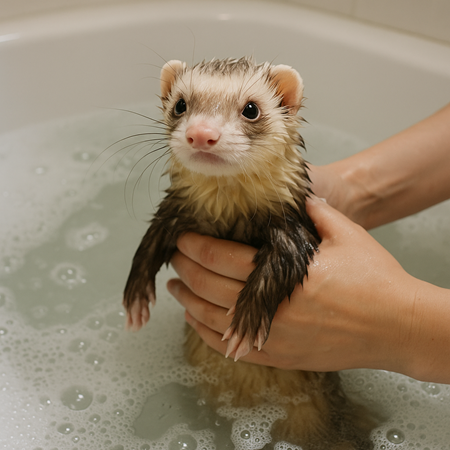
Unless your ferret goes snorkeling in butterscotch pudding or has a bad case of fleas, you really don’t need to bathe them very often. It doesn’t affect the odor much; in fact, many ferrets smell worse for a few days following a bath. The best thing you can do to control your ferret’s scent is to change their bedding every few days and keep the litter pans clean. The problem with frequent bathing is that it can cause dry skin, especially in winter. There’s nothing wrong with bathing your ferret only once a year. Bathing them once a month is probably okay, reduce that frequency if your ferret has problems with dry skin. Most ferrets don’t seem to mind baths, in fact many ferrets enjoy a bath and will swim around in the tub and even dive for the drain plug.
To get started, fill a tub or kitchen sink partway with warm water. Ferrets prefer their baths warmer than you’d expect, and this is probably because their body temperatures are pretty high. You don’t want to scald your ferret, but if you can put your hand or foot into the water and feel comfortable right away, it should be okay. If you want to let your pet play in the water, fill a tub just deeper than the ferret is tall, and provide some sort of support (a box in the tub) in case they get tired of swimming. You can also take her into the shower with you; many ferrets who don’t like baths are perfectly happy being held in a shower. Finally, bathe the ferret. Ferret shampoos are available, or no-tears baby shampoo works fine too. Pert for Kids works well if the ferret has dry skin. Wet the ferret completely, either in one half of a double sink or in a tub. Lather them from head to tail. If they start to struggle at this point, let them put their hind legs on the side of the tub while they’re being washed. Rinse thoroughly in clear, warm running water. For dry skin, some people then dip the ferret in a dilute solution of moisturizer in water, being careful to keep her head out. Older, sick, or weak ferrets can be gently cleaned using baby oil, which can also help get gooey things out of fur.
Did You Know
The brown rat (Rattus norvegicus), also known as the Norway rat, and its more acrobatic Asian cousin, the black rat (Rattus rattus), enjoy a nearly worldwide distribution, thanks to their skill at stowing away on ships.
In the mid-19th century, Jack Black, the rat catcher for Queen Victoria, found several color variations of the brown rat and domesticated those he caught. Eager owners of his pet rats included the Queen herself, and it’s rumored conservationist Beatrix Potter.
Rats’ front teeth grow 4½ to 5½ inches each year. Rats wear them down by continuously gnawing on everything around them, including cement, brick, wood, lead pipes, and other small animals.
A Hindu temple dedicated to the rat goddess Karni Mata in Deshnoke, India, houses more than 20,000 rats. Many people travel far to pay respect to the rats, which are believed to be reincarnations of Karni Mata and her clansmen.
Rats eat their own feces, purely for the nutritional value.
Related Articles & Free Email Newsletter Sign Up
3 Free Toys for Your Rodent Pet
5 Things Every Ferret Owner Should Know


Comment here